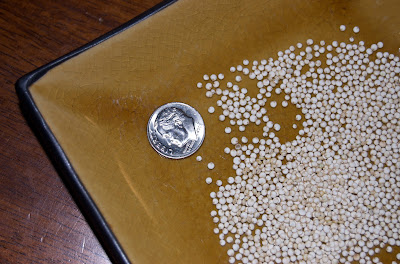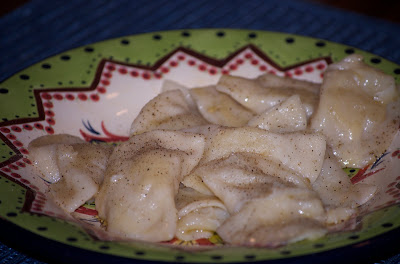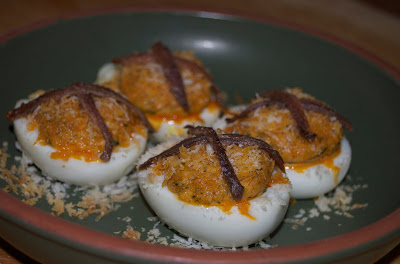Peru will not let me off easily. With its Pacific coastline and geography that includes rain forests, mountains and parched plains, not to mention an array of cultural influences, Peruvian cuisine is no easier to define and categorize in the space of a single blog entry than any other country’s has been.
Himself and I convened with a group of friends at Puro Sabor in Van Nuys to try the eats of this land on the Pacific coast of South America. We ordered a number of dishes and passed it all around the table, making for a fun and tasty but discombobulated event. As is the risk of gathering with friends for such enterprises, we were so busy talking that we didn’t pay as much attention as we should have to what we were eating. So Himself and I made a return visit a few days later, during which we sampled more dishes and completely fell in love with Peruvian food.
The most apparent thing I noticed is that ceviche is the national dish of Peru, and they serve it there with camote, or sweet potato. I couldn’t wrap my mind around that one, but as soon as I tried a bite of ceviche and sweet potato together, I was hooked. It’s sweet-n-sour bliss. Most ceviche is cut into tiny cubes, so that it “cooks” in the acid more quickly. But this fish was cut into bite-sized pieces. I’m happy to report that it was super-fresh and cooked adequately, without being so heavily acidic as to make my mouth raw. It was served with an array of accoutrements, including onions, corn on the cob and boiled potato. And take a look at those loose corn kernels. Our server explained that they had been dried in the sun and then toasted in the oven. Their crunch was a nice foil for the smooth texture of the fish and potato.
You might not be able to see it well, but along the bottom edge of the photo, you can just make out the juice on the dish that is produced by the ceviche combination. In Peru they call it leche de tigre, or tiger’s milk. Hot, salty, sweet, sour and attitudinous. Makes sense! On our return visit, Himself and I shared an order of ceviche de mariscos, which was loaded with shrimp, squid and octopus. This is the perfect way to prepare seafood that so easily overcooks. With calamari in particular, it’s easy to end up with a plate of thick and chewy rubber bands. But that didn’t happen–it was delicate and wonderful.
But I’ve gotten ahead of myself. For an appetizer, Himself ordered a papa rellena, a deep-fried ball of mashed potato stuffed with ground beef, raisins and olives. This may sound like a strange combination, but I recognize it as a culinary touch brought to the New World by Spanish explorers. Old California-style cuisine includes raisins and olives in the enchiladas. It’s a great combo, believe it or not!
I began with a pork tamale, which I’ve had dozens of times, but this one was the best yet. It was made with just a hint of saffron mixed into the masa–another of those Spanish contributions. It was incredibly good. On the return visit we had the chicken tamale, which was equally pleasing.
Himself got bisteck a lo macho, that is, a thin steak topped with shrimp, octopus and squid. The idea is to get a little seafood and red meat in each bite. This is a sensible way to do the old surf-n-turf combo, since the steak is thin and lean, and the seafood isn’t breaded and deep-fried. You get a lot of flavor without the heaviness.
Carapulcra is a stew of pork and dried potatoes, with peanuts, cinnamon and cloves. The addition of those spices shows that the Spaniards who visited brought with them ingredients they received from the Moors who settled in Spain and Portugal. The name translates as “the stew of hot stones,” which comes from the appearance of the potatoes–they look like rocks after they’ve dried and broken apart.
Ralph just had to be different and order pasta, which turns out to be authentic, too. Italian influences are strong in Peru, as are Chinese and various African. This plate of linguini and shrimp is sautéed simply with tomato and onion and called tallarin saltado de camaron.
Chicha morada is a grapey-looking beverage made from a purple variety of corn that is used only for this purpose–it isn’t eaten. Our server said that most places buy it premade, but they make their own here, and it’s a labor-intensive job. They boil the dried purple corn for four hours and mix the extract with an assortment of juices, plus cinnamon and cloves. Served without ice, you get a slightly velvety texture that becomes watered down when it’s served with ice. So if you find it on the menu, be sure to order it sin hielo, por favor.
The next day I still had Peruvian food on the brain and wanted to make something, so I stirred up a pot of quinoa vegetable soup. For two servings, you put a little vegetable oil into a pot and sauté a carrot, a stalk of celery, half a green bell pepper and some onion, all finely diced, add in two ounces of dry quinoa and a couple of cloves of garlic minced, and continue to cook until you can smell the garlic. Then add a pint of water, two diced tomatoes, and a healthy handful of chopped green cabbage. Bring it to a boil, then lower the heat and simmer for ten minutes. Season to your liking with salt and black pepper. I was amazed by what happened in that short space of time. The quinoa unfurled and gave the soup some heft, and the veggies made a nice broth.
Himself and I had a bowl of this soup with a piece of garlic bread for dinner. We expected to be hungry by bedtime, but we weren’t. And we weren’t feeling ravenous when we got up the next morning.
In that tinker-with-it way I have–and that people migrating from place to place have of taking a new food and injecting something familiar–I’m tempted next time I make this soup to toss in a handful of beans or some chicken or beef. And to give it a hearty dash of Tabasco Sauce.
One of the beauties of foods is that it’s open to endless interpretation and creativity. As long as we play with our food, how can we ever be bored?

















